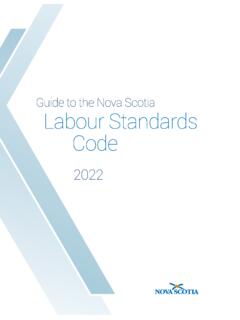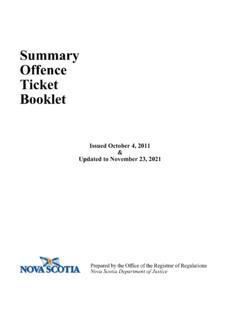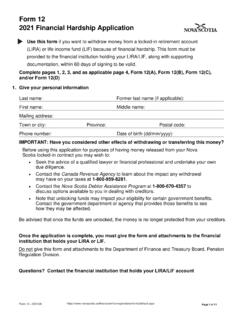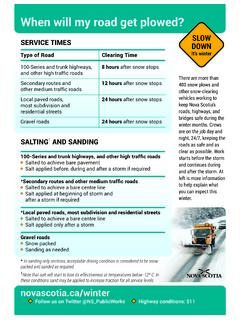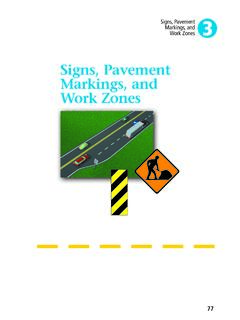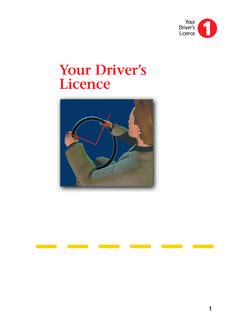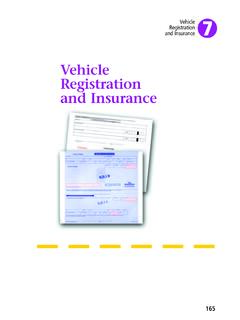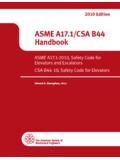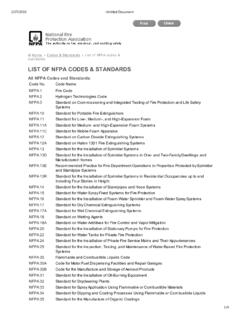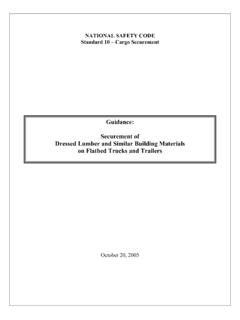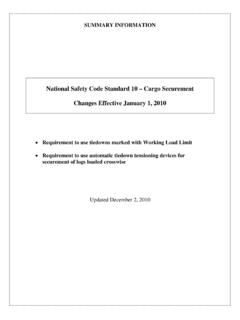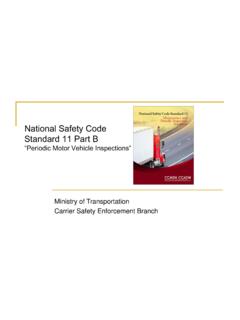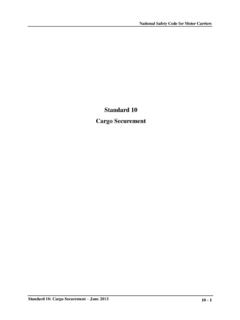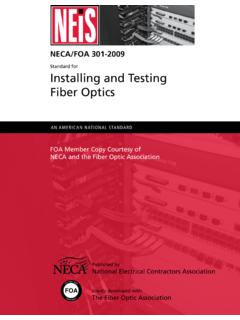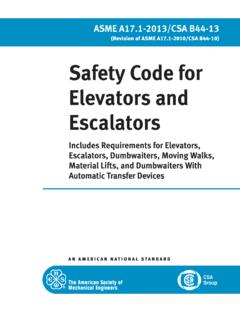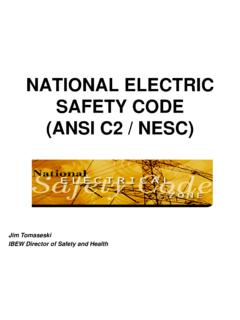Transcription of NATIONAL SAFETY CODE PROGRAM INFORMATION FOR …
1 NATIONAL SAFETY code PROGRAMINFORMATIONFORCOMMERCIAL CARRIERS/OWNERSFOR(TRUCKS AND BUSES)REV 25 Jan 2010 NATIONAL SAFETY code /Facility Audit Program1 Table of ContentsIntroduction: .. 2 Goals of NATIONAL SAFETY code .. 3 The Sixteen NATIONAL SAFETY code Standards .. 3 Carrier Profile: .. 12 Facility Audits .. 12 Carrier SAFETY Rating .. 12 Hours of Service Record Keeping .. 13 Driver Profile Record Keeping .. 13 Mechanical Fitness Record Keeping .. 14 Commercial Vehicle SAFETY Alliance Inspections (CVSA) .. 15 NSC SAFETY Plan - Drivers .. 16 NSC SAFETY Plan - Vehicles .. 17 NSC SAFETY Plan - Hours of Work.
2 18 NSC SAFETY Plan - Dangerous Goods .. 19 The United States (General INFORMATION ) .. 20 NATIONAL SAFETY code /Facility Audit PROGRAM 2 INTRODUCTION:The Atlantic Provinces in cooperation with the other provinces and territories, the Governmentof Canada, and in consultation with the transportation industry, has adopted a NATIONAL SafetyCode. (NSC) This code is made up of 16 minimum standards that will support carriers anddrivers to remain in compliance with local, NATIONAL and international rules for owning andoperating commercial of Carriera person who owns, leases or is responsible for the operation of a commercial vehicleDefinition of Commercial Vehicle(i)a truck, truck-tractor or trailer or combination thereof exceeding a registered gross weight of 4500 kg.
3 (ii)a bus designated, constructed and used for the transportation of passengers witha designated seating capacity of more than ten, including the driver, but doesnot include a bus when being operated for personal useAs a result of the NSC, the Atlantic Provinces have implemented profiling of carrierperformance in the areas of convictions, on-road inspections, collisions and facility may expect a visit by a Carrier SAFETY Officer who will review the carrier s operationand management handout explains the basic requirements for commercial carrier operation. For the actualexpression of the law including applicable exemptions, please refer to the Motor Vehicle Act & Regulations #motveh Nova Scotia does not require the following to register as commercial carriers nor will a safetyfitness certificate be issued to.
4 Emergency vehicles recreational vehicles or vehicles towing recreational vehicles while not being operatedfor the purpose of commercial venture for profit or gain buses, when being operated for personal useNational SAFETY code /Facility Audit PROGRAM Page3 There is no application fee for a carrier that makes an application for only a vehicle or vehiclesowned by a non-profit, charitable or religious organization used exclusively for transportingpassengers and not for the purpose of carrier is not required to apply for a SAFETY rating and SAFETY fitness certificate or apply for arenewal of a SAFETY fitness certificate if each commercial vehicle that the carrier owns, leases orotherwise is responsible for is a vehicle with farm plates registered to a OF NATIONAL SAFETY code .
5 Reducing fatalities, injuries, property damage and other highway incidents by assistingcommercial carriers and drivers in understanding how the NSC standards will allow them tooperate legally and SIXTEEN NATIONAL SAFETY code STANDARDS:INTRODUCTION:The Maritime Provinces in cooperation with the other provinces and territories, the Governmentof Canada, and in consultation with the transportation industry, has adopted a NATIONAL SafetyCode. (NSC) This code is made up of 16 minimum standards that will support carriers anddrivers to remain in compliance with local, NATIONAL and international rules for owning andoperating commercial of Carriera person who owns, leases or is responsible for the operation of a commercial vehicleDefinition of Commercial Vehicle(i) a truck, truck-tractor or trailer or combination thereof exceeding a registered gross weight of 4500 kg.
6 (ii) a bus designated, constructed and used for the transportation of passengers witha designated seating capacity of more than ten, including the driver, but doesnot include a bus when being operated for personal useNational SAFETY code /Facility Audit PROGRAM Page4As a result of the NSC, the Maritime Provinces have implemented profiling of carrierperformance in the areas of convictions, on-road inspections, collisions and facility audits of on-road transportation the future, many carriers may expect a visit by a facility auditor who will review the carrier soperation and management handout is to help carriers prepare for such a visit.
7 NATIONAL SAFETY code STANDARDS:NSC Standard #1 - Single Driver s LicenseNSC Standard # 2 - Knowledge and Performance TestsNSC Standard #3 - Driver Examiner TrainingNSC Standard #4 - Classified Driver s License ProgramNSC Standard #5 - Self-CertificationNSC Standard #6 - Medical RequirementsNSC Standard #7 - Carrier Record Keeping RequirementNSC Standard #8 - Short-term SuspensionsNSC Standard #9 - Hours of ServiceNSC Standard #10 - Security of LoadsNSC Standard #11 - Commercial Vehicle MaintenanceNSC Standard #12 - Commercial Vehicle SAFETY Alliance Roadside InspectionsNSC Standard #13 - Daily Trip Inspection ReportNSC Standard #14
8 - SAFETY RatingNSC Standard #15 - Facility AuditsNSC Standard #16 - First Aid TrainingNational SAFETY code /Facility Audit PROGRAM Page5 OVERVIEW OF NATIONAL SAFETY code STANDARDS:NSC Standard #1 - Single Driver s LicenseCarrier Requirement To set up and maintain a system of files on each driver for the purpose of including all ofthe INFORMATION that drivers must provide, as listed below. To determine on the basis of this INFORMATION , training and testing, whether or not thedriver is and continues to be fit to Requirement Must make a written disclosure to the commercial carrier, of any and all driver s licensesheld, including the jurisdiction (province, territory or state.)
9 Must provide class of license, status of license and the actual name in which each licenseis held. Permitted to be licensed in one jurisdiction only. Must provide a current copy of driving record before being hired, and annually authorize employer to obtain copy of driver Standard #2 - Knowledge and Performance TestsCarrier Requirement Should provide drivers and prospective drivers with the necessary training to becomequalified to drive and to remain qualified to operate the particular class of Requirement Must meet applicable medical, vision, physical ability, knowledge and skill standardsthrough the successful completion of the prescribed tests and examinations prior tooperating a commercial Standard #3 - Driver Examiner TrainingThis standard was primarily for the purpose of establishing and maintaining a consistent classlicense testing PROGRAM in each jurisdiction.
10 NATIONAL SAFETY code /Facility Audit PROGRAM Page6 NSC Standard #4 - Classified Driver s License ProgramCarrier Requirement Must ensure drivers hold the appropriate license to permit operation of the class ofvehicles authorized Must have a system to ensure that drivers remain qualified to driveDriver Requirement Must possess a valid driver s license of an appropriate class to operate the assignedvehicle, including an air brake endorsement where the vehicle is equipped with air brakes Must provide ongoing evidence of a valid licenseNSC Standard #5 - Self-CertificationProgram which allows carriers to become certified to test prospective drivers and to issuedriver s licensesNSC Standard #6 - Medical RequirementsCarrier Requirement To ensure through a monitoring system that drivers comply with filing medicalexamination reports Should ensure that any driver medically unfit to drive.
